
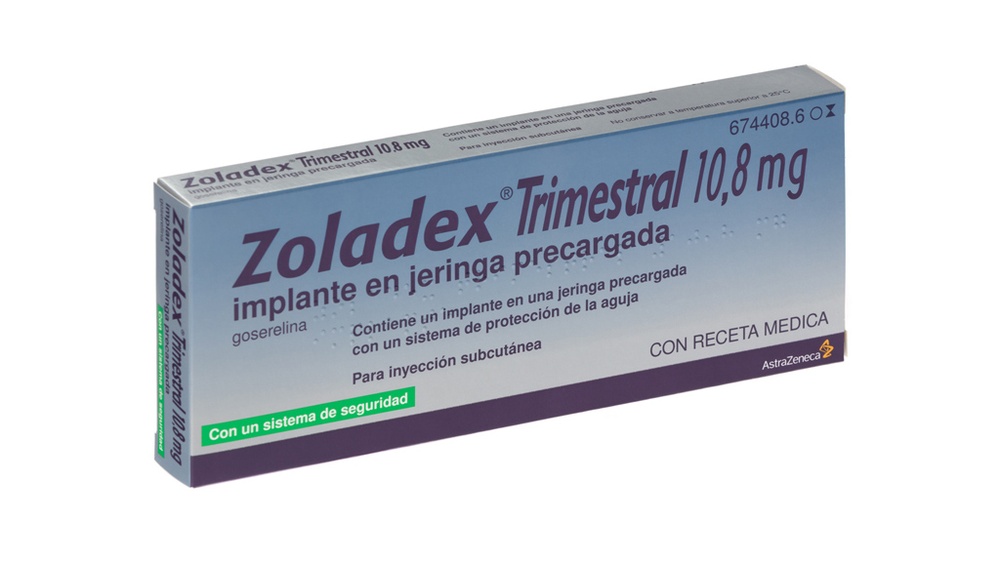
ZOLADEX TRIMESTRAL 10,8 mg IMPLANTE EM SERINGA PREENCHIDA

Pergunte a um médico sobre a prescrição de ZOLADEX TRIMESTRAL 10,8 mg IMPLANTE EM SERINGA PREENCHIDA

Como usar ZOLADEX TRIMESTRAL 10,8 mg IMPLANTE EM SERINGA PREENCHIDA
Introdução
Prospecto:informação para o utilizador
Zoladex Trimestral 10,8 mg implante em seringa precarregada
goserelina
Leia todo o prospecto atentamente antes decomeçar a usar este medicamento, porque contém informações importantes para si.
- Conserva este prospecto, porque pode ter que voltar a lê-lo.
- Se tiver alguma dúvida, consulte o seu médico ou farmacêutico.
- Este medicamento foi prescrito apenas para si, e não deve dá-lo a outras pessoas, mesmo que tenham os mesmos sintomas que si, porque pode prejudicá-las.
- Se experimentar efeitos adversos, consulte o seu médico ou farmacêutico, mesmo que se trate de efeitos adversos que não aparecem neste prospecto. Ver seção 4.
Conteúdo do prospecto:
- O que é Zoladex Trimestral 10,8 mg e para que se utiliza.
- O que necessita saber antes de começar a usar Zoladex Trimestral 10,8 mg.
- Como usar Zoladex Trimestral 10,8 mg.
- Possíveis efeitos adversos.
- Conservação de Zoladex Trimestral 10,8 mg.
- Conteúdo do envase e informação adicional.
1. O que é Zoladex Trimestral 10,8 e para que se utiliza
Zoladex Trimestral 10,8 mg pertence a um grupo de medicamentos denominados anti-hormonais, o que significa que afeta os níveis de diferentes hormonas (substâncias químicas naturais produzidas pelo organismo). Em varões, reduzirá os níveis da hormona masculina, testosterona.
Zoladex Trimestral 10,8 mg é utilizado em varões para tratar certos tipos de cancro da próstata. Zoladex Trimestral 10,8 mg não está indicado para uso em mulheres.
2. O que necessita saber antes de começar a usar Zoladex Trimestral 10,8 mg
Não use Zoladex Trimestral 10,8 mg
- Se é alérgico a goserelina ou a algum dos outros componentes deste medicamento (incluídos na seção 6).
Advertências e precauções
- Consulte o seu médico ou farmacêutico antes de começar a usar Zoladex Trimestral 10,8 mg.
- Antes de iniciar o tratamento com este medicamento, comunique ao seu médico se:
- sofreu alguma dificuldade para urinar ou sofreu molestias na zona lombar das costas,
- apresenta diabetes ou,
- tem hipertensão (pressão arterial alta).
- Os medicamentos deste tipo podem causar uma perda de cálcio dos ossos (diminuição do seu grosor). Se si apresenta alguma doença que afete a fortaleza dos seus ossos ou fatores de risco para a osteoporose [por exemplo, abuso crónico de álcool, ser fumador, tratamento a longo prazo com anticonvulsivos (medicamentos para a epilepsia ou convulsões) ou corticoides (um tipo de medicamentos anti-inflamatórios), história familiar de osteoporose], comunique ao seu médico ou enfermeiro.
- Foram notificados casos de depressão em pacientes que tomam Zoladex Trimestral 10,8 mg que pode ser grave. Se si está tomando Zoladex Trimestral 10,8 mg e apresenta depressão, informe ao seu médico.
- Informe ao seu médico se padece alguma afecção do coração ou dos vasos sanguíneos ou está sendo tratado para isso, incluindo medicamentos para controlar o ritmo cardíaco (arritmias). O risco de problemas do ritmo cardíaco pode aumentar quando se utiliza Zoladex Trimestral 10,8 mg.
- Informe imediatamente ao seu médico se apresenta dor e hematoma no abdômen ou outros sintomas de hemorragia grave, como dificuldade para respirar, mareio, pressão arterial baixa e/ou alteração do nível de consciência, que poderiam ser o resultado de lesões vasculares no local da injeção produzidas durante a administração de Zoladex Trimestral 10,8 mg.
- O tratamento com Zoladex Trimestral 10,8 mg pode provocar resultados positivos em testes antidopagem.
Em caso de ingressar em um hospital, comunique ao pessoal sanitário se está sendo tratado com Zoladex Trimestral 10,8 mg.
Crianças e adolescentes
Zoladex Trimestral 10,8 mg não está indicado para uso em crianças.
Uso de Zoladex Trimestral 10,8 mg com outros medicamentos
Informe ao seu médico, farmacêutico ou enfermeiro se está utilizando, utilizou recentemente ou pudesse ter que utilizar qualquer outro medicamento.
Zoladex Trimestral 10,8 mg pode interferir com alguns medicamentos utilizados para tratar problemas do ritmo cardíaco (por exemplo: quinidina, procainamida, amiodarona e sotalol) ou pode aumentar o risco de problemas do ritmo cardíaco quando utilizado com outros medicamentos (por exemplo: metadona (utilizada para o alívio da dor e para a desintoxicação de outros medicamentos), moxifloxacino (um antibiótico), antipsicóticos (usados para tratar doenças mentais graves)).
Gravidez e lactação
Zoladex Trimestral 10,8 mg não está indicado para uso em mulheres.
Condução e uso de máquinas
Não existe evidência de que Zoladex Trimestral 10,8 mg altere a capacidade para conduzir ou utilizar máquinas.
3. Como usar Zoladex Trimestral 10,8 mg
Siga exatamente as instruções de administração deste medicamento indicadas pelo seu médico. Em caso de dúvida, consulte novamente o seu médico, farmacêutico ou enfermeiro.
Lembre-se de que lhe administrem o seu medicamento.
O seu médico indicará a duração do seu tratamento com Zoladex Trimestral 10,8 mg. Não suspenda o tratamento antes de que o seu médico o diga.
Zoladex Trimestral 10,8 mg será administrado como uma injeção pelo seu médico ou enfermeiro, que seguirá as instruções da etiqueta do envase para uma utilização correta.
Zoladex Trimestral 10,8 mg é normalmente administrado por injeção sob a pele, cada 3 meses.
É importante que continue o tratamento com Zoladex Trimestral 10,8 mg, mesmo que se sinta bem, a menos que o seu médico decida a interrupção.
Se tiver alguma outra dúvida sobre o uso deste produto, pergunte ao seu médico ou farmacêutico.
4. Possíveis efeitos adversos
Assim como todos os medicamentos, este medicamento pode produzir efeitos adversos, embora nem todas as pessoas os sofram.
Ao administrar-lhe Zoladex Trimestral 10,8 mg, a injeção poderia produzir-lhe uma lesão na zona da administração, incluindo lesão dos vasos sanguíneos do abdômen.Em casos muito raros, isso causou uma hemorragia grave. Procure imediatamente assistência médica se notar algum dos seguintes sintomas: Dor abdominal, inchaço do abdômen, dificuldade para respirar, mareio, pressão arterial baixa e/ou qualquer alteração do nível de consciência. Estes poderiam ser sintomas de uma hemorragia grave devido à lesão acidental de algum vaso sanguíneo abdominal produzida durante a administração de Zoladex Trimestral 10,8 mg.
Efeitos adversos muito frequentes (pode afetar mais de 1 de cada 10 pessoas)
- sofocos, suoração. Estes efeitos adversos podem continuar após a suspensão do tratamento com Zoladex Trimestral 10,8 mg.
- diminuição do desejo sexual e impotência.
Efeitos adversos frequentes (pode afetar até 1 de cada 10 pessoas)
- Aumento do nível de açúcar no sangue.
- Formigamento ou adormecimento nos dedos das mãos ou dos pés.
- Erupção cutânea, que costuma ser leve e remitir sem interromper o tratamento.
- Função cardíaca diminuída, infarto. O risco de desenvolvê-los é maior quando se utiliza Zoladex juntamente com outros medicamentos (antiandrógenos) para tratar o cancro da próstata.
- Cambios na pressão arterial (elevação ou diminuição).
- Dor de ossos, geralmente no início do tratamento com Zoladex Trimestral 10,8 mg. Se lhe ocorrer isso, comunique ao seu médico, porque poderia ter que prescrever-lhe um medicamento para aliviar a dor.
- Aumento de peso.
- Inchaço das mamas.
- Reações no local da injeção, como dor, aparência de hematomas, hemorragia, vermelhidão ou inchaço na zona, ou outras reações.
- Perda da densidade mineral dos ossos (diminuição do grosso dos ossos).
- Cambios de humor e depressão (em tratamentos prolongados).
- Compressão da medula espinal.
Efeitos adversos pouco frequentes (pode afetar até 1 de cada 100 pessoas)
- Reações de hipersensibilidade ao medicamento.
- Dor nas articulações.
- Molestias nas mamas.
- Cambios de humor e depressão (em tratamentos curtos).
- Obstrução dos ureteres (conduto que transportam a urina desde os rins até a bexiga), que pode causar dificuldade para urinar ou molestias na zona lombar das costas.
Efeitos adversos raros (pode afetar até 1 de cada 1.000 pessoas)
- Reação anafiláctica (reação alérgica grave).
Efeitos adversos muito raros (pode afetar até 1 de cada 10.000 pessoas)
- Transtornos psicóticos que podem fazer com que tenha alucinações, transtornos do pensamento e cambios de personalidade.
- Desenvolvimento de um tumor na hipófise (uma glândula endócrina que está na cabeça). Se tem um tumor na hipófise, Zoladex Trimestral 10,8 mg pode provocar sangramento do tumor. Os tumores na hipófise podem causar dor de cabeça, malestar, perda de visão e até podem fazer com que perca a consciência.
Efeitos adversos de frequência não conhecida (não se pode estimar a frequência a partir dos dados disponíveis)
- Queda de cabelo, especialmente perda de pelo corporal.
- Alterações no electrocardiograma (prolongamento do intervalo QT).
- Cambios no número de células do sangue (observado em uma análise de sangue).
- Coágulos de sangue nos pulmões (que causam dor no peito e dificuldade para respirar) e inflamação do tecido que rodeia as estruturas (alvéolos) dos pulmões onde se absorve o oxigênio (pneumonia intersticial) (que causa sintomas como tos e dificuldade para respirar).
- Alteração do fígado.
Comunicação de efeitos adversos.
Se experimentar qualquer tipo de efeito adverso, consulte o seu médico, farmacêutico ou enfermeiro, mesmo que se trate de possíveis efeitos adversos que não aparecem neste prospecto. Também pode comunicá-los diretamente através do Sistema Espanhol de Farmacovigilância de Medicamentos de Uso Humano: www.notificaRAM.es. Mediante a comunicação de efeitos adversos, si pode contribuir para proporcionar mais informações sobre a segurança deste medicamento.
5. Conservação de Zoladex Trimestral 10,8 mg
Mantenha este medicamento fora da vista e do alcance das crianças.
Não conserve a temperatura superior a 25ºC.
Conservar no embalagem original.
Não utilize Zoladex Trimestral 10,8 mg após a data de caducidade que aparece no envase e o sobre após CAD. A data de caducidade é o último dia do mês que se indica.
Os medicamentos não devem ser jogados pelos deságues nem para o lixo. Deposite os envases e os medicamentos que não precisa no Ponto SIGRE da farmácia. Em caso de dúvida, pergunte ao seu farmacêutico como se livrar dos envases e dos medicamentos que não precisa. Dessa forma, ajudará a proteger o meio ambiente.
6. Conteúdo do envase e informação adicional
Composição de Zoladex Trimestral 10,8 mg
- O princípio ativo é goserelina (como acetato). Cada implante contém 10,8 mg de goserelina.
- Os outros componentes são uma mistura de copolímeros láctido-glicólido de alto e baixo peso molecular.
Aspecto do produto e conteúdo do envase
O medicamento apresenta-se em forma de implante de 10,8 mg em uma seringa precarregada dentro de um sobre selado.
O implante é estéril, cor creme e libera o fármaco de forma prolongada.
O sobre contém, no seu interior, além disso, um dessecante.
A seringa precarregada dispõe de um dispositivo de segurança (clip-azul) e de um sistema de proteção da agulha.
Titular da autorização de comercialização e responsável pela fabricação
Titular da autorização de comercialização
AstraZeneca Farmacêutica Spain, S.A.
C/ Puerto de Somport 21-23
28050 Madrid
Espanha
Responsável pela fabricação
AstraZeneca AB
Gärtunavägen
SE-152 57 Södertälje
Suécia
Outras apresentações
Zoladex 3,6 mg: Envase contendo um implante de 3,6 mg em uma seringa precarregada dentro de um sobre selado, que, além disso, contém no seu interior um dessecante. A seringa precarregada dispõe de um dispositivo de segurança (clip-vermelho) e de um sistema de proteção da agulha.
Data da última revisão desteprospecto: Fevereiro 2020
A informação detalhada e atualizada deste medicamento está disponível na página Web da Agência Espanhola de Medicamentos e Produtos Sanitários (AEMPS) http://www.aemps.gob.es/
<----------------------------------------------------------------------------------------------------------------------------------?
Esta informação está destinada apenas a profissionais de saúde:
Zoladex Trimestral 10,8 mg deveser administrado mediante injeção cutânea – leia e compreenda todas as instruções completamente antes da sua administração.
- Deite o paciente em uma posição confortável, com a parte superior do corpo ligeiramente elevada. Limpe a zona abdominal da injeção com um algodão impregnado em um agente desinfectante (álcool, etc...).
NOTA: Deve ter precaução enquanto procede à injeção de Zoladex Trimestral 10,8 mg na parede abdominal anterior, devido à proximidade da artéria epigástrica inferior subyacente e às suas ramificações. Os pacientes muito magros poderiam ter um alto risco de lesão vascular.
- Examine o sobre e a seringa para ver se estão danificados. Retire a seringa do sobre aberto e mantenha-a inclinada para a luz.
Verifique se observa pelo menos parte do implante de Zoladex Trimestral 10,8 mg. (Figura 1).
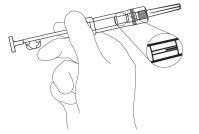 Figura 1
Figura 1
- Retire suavemente a pestaña de plástico de segurança da seringa de cor azul e descarte-a. (Figura 2).
Retire o capuchão que protege a agulha. Ao não ser um injetável líquido, não há necessidade de eliminar as bolhas de ar, porque ao tentar isso o implante de Zoladex Trimestral 10,8 mg poderia deslocar-se.
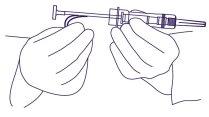 Figura 2
Figura 2
- Segure a seringa em torno do sistema de proteção, utilizando uma técnica asséptica. Pegue um dobra da pele do paciente e introduza a agulha com um ângulo de inclinação pouco pronunciado (30 a 45 graus).
Com a abertura da agulha para cima, introduza a agulha no tecido subcutâneoda parede abdominal anterior abaixo da linha do umbigo, até que o sistema de proteção toque a pele do paciente. (Figura 3).
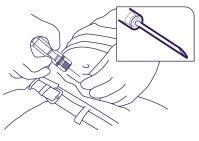 Figura 3
Figura 3
NOTA: A seringa de Zoladex Trimestral 10,8 mg não pode ser utilizada para a aspiração. Se a agulha hipodérmica penetra em um vaso grande, o sangue será visto instantaneamente na câmara da seringa. Se penetrar um vaso, retire a agulha e controle imediatamente qualquer sangramento resultante, monitorizando o paciente para qualquer sinal ou sintoma de hemorragia abdominal. Depois de se certificar de que o paciente está hemodinamicamente estável, pode-se injetar outro implante de Zoladex Trimestral 10,8 mg com uma nova seringa em outra zona. Extremar a precaução quando administre Zoladex Trimestral 10,8 mg nos pacientes com um IMC baixo e/ou para os pacientes que recebem doses anticoagulantes completas.
- Não penetre o músculo, nem o peritônio. Na Figura 4, a seguir, são mostradas uma sujeição e ângulo de exposição incorretos.
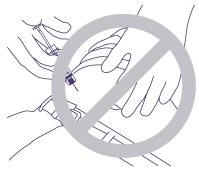 Figura 4
Figura 4
- Pressione o êmbolo completamente, até que não possa pressionar mais, com o fim de depositar o implante de Zoladex Trimestral 10,8 mg e de ativar o sistema de proteção. Poderia ouvir um “click” e notar como o sistema de proteção se ativa, deslizando automaticamente para recobrir a agulha. Se o êmbolo não for pressionado completamente, o sistema de proteção NÃO se ativa.
NOTA:A agulha não se retrai.
- Continue segurando a seringa como mostrado na Figura 5, retire a agulha permitindo que o sistema de proteção continue deslizando e cobrindo a agulha.
Descarte a seringa em um contenedor, de acordo com a normativa local.
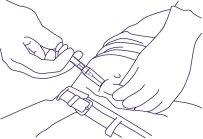 Figura 5
Figura 5
NOTA: No improvável caso de necessidade de eliminar cirurgicamente um implante de Zoladex Trimestral 10,8 mg, este pode ser localizado por ultrassom.

Quanto custa o ZOLADEX TRIMESTRAL 10,8 mg IMPLANTE EM SERINGA PREENCHIDA em Espanha em 2025?
O preço médio do ZOLADEX TRIMESTRAL 10,8 mg IMPLANTE EM SERINGA PREENCHIDA em dezembro de 2025 é de cerca de 380.93 EUR. Os valores podem variar consoante a região, a farmácia e a necessidade de receita. Confirme sempre com uma farmácia local ou fonte online para obter informações atualizadas.
- País de registo
- Preço médio em farmácia380.93 EUR
- Substância ativa
- Requer receita médicaSim
- Fabricante
- Esta informação é apenas para referência e não constitui aconselhamento médico. Consulte sempre um médico antes de tomar qualquer medicamento. A Oladoctor não se responsabiliza por decisões médicas baseadas neste conteúdo.
- Alternativas a ZOLADEX TRIMESTRAL 10,8 mg IMPLANTE EM SERINGA PREENCHIDAForma farmacêutica: IMPLANTE, 3,6 mgSubstância ativa: goserelinFabricante: Astrazeneca Farmaceutica Spain S.A.Requer receita médicaForma farmacêutica: INJETÁVEL, 42 mgSubstância ativa: leuprorelinFabricante: Accord Healthcare S.L.U.Requer receita médicaForma farmacêutica: INJETÁVEL, 0,1 mgSubstância ativa: triptorelinFabricante: Ipsen Pharma S.A.Requer receita médica
Alternativas a ZOLADEX TRIMESTRAL 10,8 mg IMPLANTE EM SERINGA PREENCHIDA noutros países
As melhores alternativas com o mesmo princípio ativo e efeito terapêutico.
Alternativa a ZOLADEX TRIMESTRAL 10,8 mg IMPLANTE EM SERINGA PREENCHIDA em Polónia
Alternativa a ZOLADEX TRIMESTRAL 10,8 mg IMPLANTE EM SERINGA PREENCHIDA em Ukraine
Médicos online para ZOLADEX TRIMESTRAL 10,8 mg IMPLANTE EM SERINGA PREENCHIDA
Avaliação de posologia, efeitos secundários, interações, contraindicações e renovação da receita de ZOLADEX TRIMESTRAL 10,8 mg IMPLANTE EM SERINGA PREENCHIDA – sujeita a avaliação médica e regras locais.











